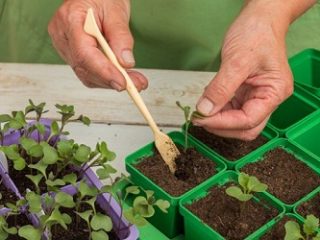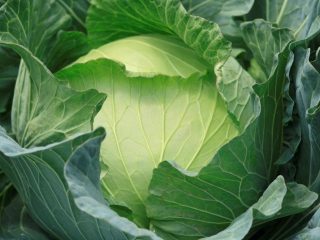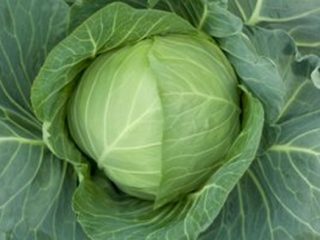Content
You can store early cabbage both in a country house and in an apartment. In the first case, a basement, cellar or pantry is suitable, in the second - a refrigerator or balcony. Please note that cabbage is very demanding on storage conditions. And even if all parameters are met, early varieties last no more than 2.5 months. If the harvest is large, some of it should be immediately sent for fermentation or pickling.
Which varieties to choose for storage
For winter storage, you need to especially carefully select early cabbage varieties. Almost all varieties produce a harvest already in the first half of summer, and this complicates storage. Even if all conditions are met, the heads of cabbage last only 1.5-2 months, after which they inevitably begin to deteriorate.
Early cabbage is not suitable for long-term storage, so it is better to choose mid-season varieties, and even better, late ones. They ripen for quite a long time, and even after harvesting they continue to sing, acquiring even more interesting flavor shades.The following varieties are recommended for storage: Amager, Slava, Zimovka, Orbita, Moscow late, Turkiz, Valentina.
Preparing heads of cabbage for storage
When preparing early cabbage for storage, it is necessary to properly cut the crop, sort the heads of cabbage, and then pack them well. This approach will allow you to preserve vegetables for two months or more.
Harvest cutting rules
If you leave the heads of cabbage with roots, they will last longer. But they will have to be cleaned of wet soil, which can cause rotting of neighboring forks. Therefore, it is better to simply cut the stalk flush with the foliage. It is permissible to leave a small stump of up to 1 cm. The cuts should be smooth and neat; they do not need to be processed.
Cleaning and sorting
On the eve of storage, it is necessary to carry out certain preparations:
- All damaged leaves, as well as those that do not fit tightly, must be removed from the head of cabbage. They are not needed because they will rot quickly anyway.
- Then the forks are wrapped in regular cling film (laid in several layers). It is desirable that it be wide. Air bubbles should not remain on the surface.
- There is another packaging option - wrap it tightly in paper and put it in a strong plastic bag, which should have several holes for air access. Over time, the paper will become damp and should be replaced.
- Then you can send the heads of cabbage for storage. They need to be inspected periodically in order to remove rotten forks in a timely manner.
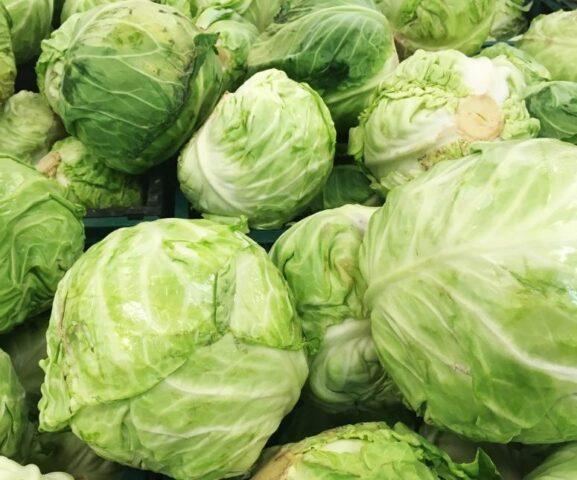
For long-term storage, only healthy and dense specimens without damage are selected
As for sorting, you should pay attention not so much to the sizes and varieties, but to the condition of the heads of cabbage. The best heads of early cabbage are chosen for storage.They should be dense and healthy, intact and without damage. The forks must not show signs of disease or insect damage. There is no need to throw away unsuitable heads of cabbage - they are used fresh, and also for preservation, for example, sent for pickling.
Fresh storage conditions
Early, like other varieties of cabbage (medium, late) are very demanding on storage conditions. They work well only at specific temperatures (the range is narrow) and high humidity. The room should be dark; it is equally important to ensure a constant flow of air so that moisture does not stagnate and mold does not form.
Temperature
The permissible storage temperature range is from 0 to +5 degrees. In this case, a narrower interval from 0 to +2 is considered ideal. If you can constantly maintain this temperature, early cabbage will last for more than two months (usually this is the maximum period). If the temperature periodically drops below 0, the heads of cabbage will freeze and lose their taste, although they will not spoil. If it is quite warm, the flesh will quickly soften and may rot.
Air humidity
Another important parameter is air humidity. Cabbage cannot tolerate dry air, but elevated levels are also harmful and can lead to rotting and mold. The optimal range is considered to be 80-90%. The acceptable lower limit is 75%. To reliably determine humidity, it is recommended to purchase an inexpensive hygrometer (it often comes with a thermometer).
Tara
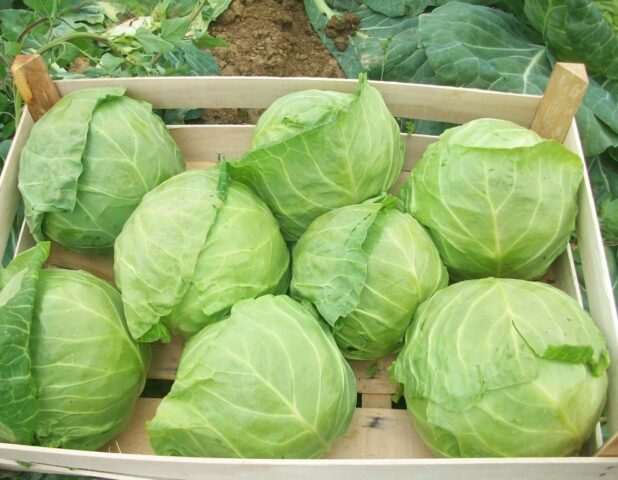
To store early cabbage, it is recommended to choose ordinary wooden boxes
Containers made from natural material have several advantages:
- excellent air permeability;
- affordable;
- roomy;
- Standard sizes allow containers to be placed in several rows.
It is better to choose not solid boxes, but ones with holes. Then they will allow air to pass through even better - there is less chance that the hummocks will rot. There is no need to cover the container with a lid. Another piece of advice is that containers should not be placed directly on the floor of a cellar or other room. It is better to install it on a support, for example, on a wooden pallet. It is undesirable to use metal and concrete stands - they give off extreme cold.
How to store early cabbage at home
There are several ways to store forks available at home. The easiest option is to put them in the refrigerator. It can be placed on the balcony or placed in a pantry or cellar.
In a refrigerator
You can store early white cabbage in the refrigerator. Before this, it must be wrapped in paper or plastic film. It is necessary to wrap it tightly and then place it on a vegetable shelf or in a freshness zone (available in modern models). If possible, the heads of cabbage should be placed in a box, the walls of which are insulated with foam, or in a special thermal container.
On the balcony
Since early cabbage ripens already in June-July, it will not be possible to immediately plant it on the balcony. First, you should keep the forks in the cellar or refrigerator. Then, when the temperature on the balcony does not rise above +5 degrees, the harvest can be transferred. The forks must be covered with burlap or other dense fabric so that they are not exposed to direct sunlight.
In the cellar
Another way to store early cabbage is in the cellar.This is one of the best options, since it can provide both temperature conditions and suitable humidity. The heads of cabbage are placed in boxes and placed in rows. The cellar needs to be ventilated periodically. Can be stored for up to 2-2.5 months.
The width should correspond to one head of cabbage, the length should be 10 pieces. The forks of early cabbage are laid with the stalks facing up, and the covering leaves are tucked in slightly. Then they are sprinkled with dry soil, and foliage, peat or straw are placed on top.
In the pantry
Storing early cabbage in the pantry is also possible if you can maintain a stable temperature. As a rule, this is only possible in a country house or country house - in a city apartment, even in a niche for food it is too warm.
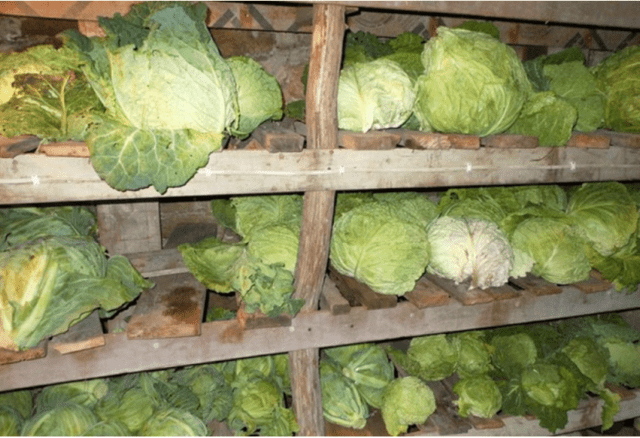
You can make wooden shelves in the pantry to accommodate the entire harvest.
Shelf life of early cabbage
You can preserve the harvest of early cabbage for the winter in different ways, and the timing largely depends on the crop:
- storage of early varieties - up to 60 days;
- mid-season varieties - about 90 days;
- late ripening - 3-4 months, sometimes several weeks longer.
There are also some kind of record holders for shelf life. Thus, “Wintering” can be kept for up to seven months, “Gift” - at least five. Dutch hybrids “Lennox”, “Marathon” and “Bartolo” can be stored for even longer.
To increase the shelf life of early cabbage, it is recommended to follow certain growing rules:
- If possible, make a bed from loamy soil rather than sandy loam.
- Do not over-water, especially if the autumn is rainy.
- Use fertilizers in moderation, especially nitrogen. They are used only in the early stages of growth.
Preserving cabbage
A reliable way to preserve early cabbage, which is suitable for beginners and experienced gardeners, is to preserve the crop for the winter. One of the most popular methods of preparation is fermentation. For cooking, take several products in the following quantities:
- cabbage – 1 kg;
- carrots – 0.5 kg;
- salt 20-25 g.
The sequence of actions is as follows:
- Grind the carrots using a coarse grater.
- Shred the cabbage.
- Combine with carrots and sprinkle with salt.
- Mix thoroughly, but do not mash the vegetables.
- Line the bottom of the container with large early cabbage leaves.
- Place the vegetables as tightly as possible.
- Fill the container to the top and cover again with large leaves.
- Place a flat plate or lid on top.
- Place a load weighing 3-5 kg or more on it.
- Remove the lid every day and pierce the mixture with a wooden stick.
- After three days, move the tub to a cold place, for example, in a refrigerator or on a balcony.
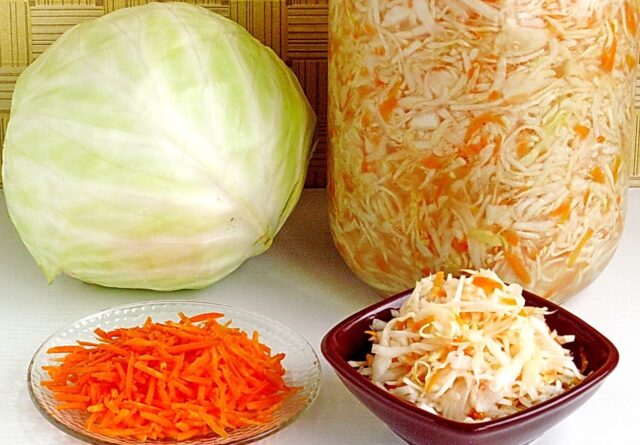
In a glass jar placed in the refrigerator, sauerkraut can be kept for up to six months.
To store early cabbage for the winter, it is recommended to pickle it. You will need the following ingredients:
- cabbage – 1 kg;
- carrots – 1 pc.;
- sugar – 1 tbsp. l.;
- water – 1 l;
- vinegar essence – 1 tsp. (or food vinegar 9% - 7 tsp);
- salt – 2 tbsp. l.;
- fresh garlic – 3 cloves;
- pepper – 10 peas;
- bay leaf – 2-3 pcs.
To prepare the workpiece, you must proceed as follows:
- Sterilize a 1 liter jar.
- Place peppers, chopped garlic cloves and bay leaves on the bottom.
- Shred forks.
- Grind the carrots on a coarse grater.
- Fill the container to the top and press down a little.
- Prepare the marinade with salt and sugar, turn it off after boiling and add vinegar.
- Pour the marinade into a jar and roll up the lid.
- Wrap it in a blanket and let it cool completely, and then store it in the refrigerator or on the balcony.
Conclusion
You can store early cabbage in a cool and fairly humid place. It should be well ventilated so that the forks do not become moldy. They are periodically inspected and rotten specimens are removed. If it is necessary to preserve the crop throughout the winter, late-ripening rather than early-ripening varieties should be used.
